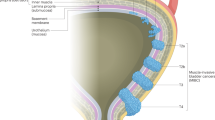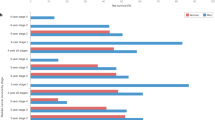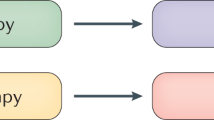Abstract
Bladder cancer is the fifth most common malignancy in the USA and the most expensive to treat on a per-patient basis. Despite its prevalence, morbidity, mortality and associated cost of management, bladder cancer remains grossly under-recognized as a public health concern and underfunded scientifically. Although 5-year survival rates for patients with prostate or kidney cancer have improved tremendously in the past 30 years, progress in bladder cancer has stalled. A renewed interest from the clinical and research communities, as well as a young and eager advocacy network, are raising the profile of bladder cancer. As awareness and funding of bladder cancer increase, improved diagnostics, therapeutics and health services for patients with the disease will develop accordingly.
This is a preview of subscription content, access via your institution
Access options
Subscribe to this journal
Receive 12 print issues and online access
$209.00 per year
only $17.42 per issue
Buy this article
- Purchase on SpringerLink
- Instant access to full article PDF
Prices may be subject to local taxes which are calculated during checkout
Similar content being viewed by others
References
Siegel, R., Ward, E. & Brawley, O. Cancer statistics, 2011: The impact of eliminating socioeconomic and racial disparities on premature cancer deaths. CA Cancer J. Clin. 61, 212–236 (2011).
Siegel, R., Naishadham, D. & Jemal, A. Cancer statistics, 2012. CA Cancer J. Clin. 62, 10–29 (2012).
Botteman, M. F. et al. The health economics of bladder cancer: a comprehensive review of the published literature. Pharmacoeconomics 21, 1315–1330 (2003).
Lotan, Y. et al. Key concerns about the current state of bladder cancer: a position paper from the Bladder Cancer Think Tank, the Bladder Cancer Advocacy Network, and the Society of Urologic Oncology. Cancer 115, 4096–4103 (2009).
Soloway, M. S. Bladder carcinoma: where are the patient advocates? Cancer 8, 1559–1562 (2005).
Williamson, J. M. L., Jones, I. H. & Hocken, D. B. How does the media profile of cancer compare with prevalence? Ann. R. Coll. Surg. Engl. 93, 9–12 (2011).
Bjurlin, M. A. et al. Ethnicity and smoking status are associated with awareness of smoking related genitourinary disease. J. Urol. 188, 724–728 (2012).
Hansen, R. P. et al. Time intervals from first symptom to treatment of cancer: a cohort study of 2,212 newly diagnosed cancer patients. BMC Health Serv. Res. 11, 284–291 (2011).
Hollenbeck, D. K. et al. Delays in diagnosis and bladder cancer mortality. Cancer 116, 5235–5242 (2010).
Messing, E. M. et al. Long-term outcome of hematuria screening for bladder cancer in men. Cancer 107, 2173–2179 (2006).
Gore, J. L., Lai, J., Setodji, C. M., Litwin, M. S. & Saigal, C. S. Mortality increases when radical cystectomy is delayed more than 12 weeks: results from a Surveillance, Epidemiology, and End Results-Medicare analysis. Cancer 115, 988–996 (2009).
Bladder Cancer Advocacy Network [online], (2013).
Carter, A. J. & Nguyen, C. N. A comparison of cancer burden and research spending reveals discrepancies in the distribution of research funding. BMC Public Health 12, 526–537 (2012).
Bachir, B. G. et al. Demographic analysis of randomized controlled trials in bladder cancer. BJU Int. http://dx.doi.org/10.1111/j.1464-410X.2012.11401.x
Soloway, M. S. Bladder cancer: Lack of progress in bladder cancer—what are the obstacles? Nat. Rev. Urol. 10, 5–6 (2012).
Chamie, K. et al. Compliance with guidelines for patients with bladder cancer: variations in the delivery of care. Cancer 117, 5392–5401 (2011).
Madeb, R. et al. Treatment of non-muscle invading bladder cancer: do physicians in the United States practice evidence based medicine? The use and economic implications of intravesical chemotherapy after transurethral resection of bladder tumors. Cancer 115, 2660–2670 (2009).
Lee, C. T. et al. Economic and humanistic consequences of preventable bladder tumor recurrences in nonmuscle invasive bladder cancer cases. J. Urol. 188, 2114–2119 (2012).
Herr, H. W. et al. Surgical factors influence bladder cancer outcomes: a cooperative group report. J. Clin. Oncol. 22, 2781–2789 (2004).
Steven, K. & Poulsen, A. L. Radical cystectomy and extended pelvic lymphadenectomy: survival of patients with lymph node metastasis above the bifurcation of the common iliac vessels treated with surgery only. J. Urol. 178, 1218–1223 (2007).
SWOG. SWOG S1011 Bladder Cancer Trial: patient information [online], (2013).
Spencer, B. A. et al. Quality-of-care indicators for early-stage prostate cancer. J. Clin. Oncol. 21, 1928–1936 (2003).
Cooperberg, M. R., Porter, M. P. & Konety, B. R. Candidate quality of care indicators for localized bladder cancer. Urol. Oncol. 27, 435–442 (2009).
Sutton, M. et al. Reduced hospital mortality with hospital pay for performance in England. N. Engl. J. Med. 367, 1821–1828 (2012).
Epstein, A. M. Will pay for performance improve quality of care? The answer is in the details. N. Engl. J. Med. 367, 1852–1853 (2012).
Gonzalgo, M. L., Schoenberg, M. P. & Rodriguez, R. Biological pathways to bladder carcinogenesis. Semin. Urol. Oncol. 18, 256–263 (2000).
Adams, R. M. Databases and the future of clinical trials in bladder cancer. Urol. Oncol. 25, 330–332 (2007).
Chang, S. S. et al. 12th Annual meeting of the Society of Urologic Oncology (SUO) bladder cancer sessions I and II summary report. Urol. Oncol. 30, 944–947 (2012).
Svatek, R. S. et al. Summary of the 6th annual bladder cancer think tank: New directions in urologic research. Urol. Oncol. http://dx.doi.org/10.1016/j.urolonc.2011.12.017.
Lerner, S. P. Bladder cancer clinical trials. Urol. Oncol. 23, 275–279 (2005).
National Cancer Institute. Clinical Trials [online], (2013).
Mallin, K., David, K. A., Carroll, P. R., Milowsky, M. I. & Nanus, D. M. Transitional cell carcinoma of the bladder: Racial and gender disparities in survival (1993 to 2002), stage and grade (1993 to 2007). J. Urol. 185, 1631–1636 (2011).
Grossman, H. B. et al. Neoadjuvant chemotherapy plus cystectomy compared with cystectomy alone for locally advanced bladder cancer. N. Engl. J. Med. 349, 859–866 (2003).
Fedeli, U., Fedewa, S. A. & Ward, E. M. Treatment of muscle invasive bladder cancer: evidence from the National Cancer Database, 2003 to 2007. J. Urol. 185, 72–78 (2011).
International Collaboration of Trialists et al. International phase III trial assessing neoadjuvant cisplatin, methotrexate, and vinblastine chemotherapy for muscle-invasive bladder cancer: long-term results of the BA06 30894 trial. J. Clin. Oncol. 29, 2171–2177 (2011).
Advanced Bladder Cancer (ABC) Meta-analysis Collaboration. Adjuvant chemotherapy for invasive bladder cancer (individual patient data). Cochrane Database Syst. Rev. CD006018 (2006).
Konety, B. R., Joyce, G. F. & Wise, M. Bladder and upper tract urothelial cancer. J. Urol. 177, 1636–1645 (2007).
Keegan, K. A. et al. Changing utilization of neoadjuvant and adjuvant chemotherapies for muscle-invasive urothelial carcinoma after publication of landmark manuscripts [abstract 527]. 187, e216–e217 (2012).
Alva, A. S. et al. Efficient delivery of radical cystectomy after neoadjuvant chemotherapy for muscle-invasive bladder cancer: a multidisciplinary approach. Cancer 188, 44–53 (2012).
Kurpad, R. et al. A multidisciplinary approach to the management of urologic malignancies: does it influence diagnostic and treatment decisions? Urol. Oncol. 29, 378–382 (2011).
Apolo, A. B., Grossman, H. B., Bajorin, D., Steinberg, G. & Kamat, A. M. Practical use of perioperative chemotherapy for muscle-invasive bladder cancer: summary of session at the Society for Urologic Oncology annual meeting. Urol. Oncol. 30, 772–780 (2012).
Howlander, N. et al. SEER Cancer Statistics Review: 1975–2009. Surveillance Epidemiology and End Results [online], (2013).
Ko, C. & Chaudhry, S. The need for a multidisciplinary approach to cancer care. J. Surg. Res. 105, 53–57 (2002).
Bassett, J. C. et al. Impact of a bladder cancer diagnosis on smoking behavior. J. Clin. Oncol. 30, 1871–1878 (2012).
Pawlson, L. G. et al. Patient-centered medical home from vision to reality. California Department of Health Care Services [online], (2013).
Sia, C., Tonniges, T. F., Osterhus, E. & Taba, S. History of the medical home concept. Pediatrics 113, 1473–1478 (2004).
Peikes, D. et al. Early evidence on the Patient-Centered Medical Home. Agency for Healthcare Research and Quality [online], (2013).
Wender, R. C. & Altshuler, M. Can the medical home reduce cancer morbidity and mortality? Prim. Care 36, 845–858, (2009).
Chamie, K. et al. Quality of care in patients with bladder cancer: a case report? Cancer 118, 1412–1421 (2012).
Sprandio, J. D. Oncology patient-centered medical home and accountable cancer care. Commun. Oncol. 7, 565–572 (2010).
Author information
Authors and Affiliations
Contributions
A. L. Kaplan and K. Chamie researched data for the article, contributed to the discussion of content and wrote the article. All authors reviewed the manuscript before submission.
Corresponding author
Ethics declarations
Competing interests
The authors declare no competing financial interests.
Rights and permissions
About this article
Cite this article
Kaplan, A., Litwin, M. & Chamie, K. The future of bladder cancer care in the USA. Nat Rev Urol 11, 59–62 (2014). https://doi.org/10.1038/nrurol.2013.180
Published:
Issue Date:
DOI: https://doi.org/10.1038/nrurol.2013.180
This article is cited by
-
Epidermal growth factor expression as a predictor of chemotherapeutic resistance in muscle-invasive bladder cancer
BMC Urology (2018)
-
RIPK4 promotes bladder urothelial carcinoma cell aggressiveness by upregulating VEGF-A through the NF-κB pathway
British Journal of Cancer (2018)
-
CXCL2/MIF-CXCR2 signaling promotes the recruitment of myeloid-derived suppressor cells and is correlated with prognosis in bladder cancer
Oncogene (2017)
-
miR-199a-5p suppresses human bladder cancer cell metastasis by targeting CCR7
BMC Urology (2016)
-
Regulator of cullins-1 expression knockdown suppresses the malignant progression of muscle-invasive transitional cell carcinoma by regulating mTOR/DEPTOR pathway
British Journal of Cancer (2016)



